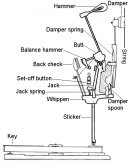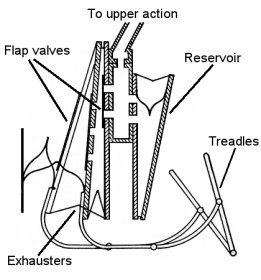General
To understand the workings of a player piano, it is
necessary to first understand the key component parts and how they
are arranged within the instrument. A basic appreciation of the standard
upright piano action is also desirable. To see cross-sectional views
of a typical player, click on the thumbnail images below.
 
The
Roll Playing System
The player mechanism, typically referred to as the
'pneumatic stack', is located in the upper portion of the instrument
and connected to the piano action by series of push-rods. For each
note of the piano, there is a small pneumatic, a valve
assembly, a soft flexible leather pouch and a bleed.
The tracker bar has a row of equally spaced holes, each of
which is connected to a channel, via a small pipe. The chamber
is kept under vacuum by the foot operated bellows. The pneumatic
is connected to the piano action by a simple linkage.
The diagram below shows the whole assembly, firstly in resting and
then playing positions.
When
a roll perforation passes over a tracker bar hole, air is admitted,
causing the pouch to move upwards under suction inside the chamber.
The valve rises accordingly, uncovering the top of the chamber and
resting against its upper seat. This in turn connects the
pneumatic to the vacuum supply, forcing it to collapse under atmospheric
pressure and to operate the piano action.
The
bleed, which connects the channel to the chamber, allows the pouch
to assume its correct resting position after a note has finished
playing, by equalising the pressure above and below. The diameter
of the bleed is necessarily much smaller than that of the corresponding
tracker bar hole.
The
take-up spool, which is driven by an air
powered motor, transports the music roll over the tracker bar
at a speed that may be varied by means of a control lever. The tempo
of the music is unaffected by variations in the force at which the
pedals are operated, due to the presence of a governing device.
Large
diameter rubber hoses provide a connection between the main bellows
and pneumatic stack, in addition to other auxiliary devices. Rubber
tubing of small diameter is also used throughout, particularly in
the case of the tracker bar, each port of which has an individual
connection to its corresponding valve assembly.
The
Exhauster Bellows
 The
purpose of the exhauster bellows is to provide suction, which is the
motive force for virtually all player systems. Located in the lower
section of the piano, it usually consists of a large bellows
assembly connected to two foot treadles. The bellows are of wooden
construction, covered with heavy duty rubberised cotton cloth. The
purpose of the exhauster bellows is to provide suction, which is the
motive force for virtually all player systems. Located in the lower
section of the piano, it usually consists of a large bellows
assembly connected to two foot treadles. The bellows are of wooden
construction, covered with heavy duty rubberised cotton cloth.
As the
exhausters are alternately opened and closed by the action of the
feet upon the treadles, air within the system is exhausted
into the atmosphere. This naturally has the effect of lowering the
pressure within the player mechanism. The purpose of the external
leather flap valves is to allow the exhausters to discharge
the air extracted during the forward stroke of the treadles. Upon
the return stroke, the internal valve prevents any feeback of air
to the bellows system. The reservoir provides a necessary measure
of equalisation for the vacuum level within the player mechanism.
The
more sophisticated and fully automatic 'reproducing' pianos, described
later, utilise an electrically operated suction pump instead.
Auxiliary
Devices
Most players also incorporate a number of auxiliary devices,
the most common of which is a system that keeps the music roll in perfect
alignment with the tiny holes of the tracker bar.
Others
include a means of automatically operating the soft and sustain pedals
of the piano from perforations within the roll. Another popular feature,
known in Aeolian terminology as the 'Themodist', allows selected notes
to be accented, a concept known as 'theming' and also provides some
control over the dynamics of the music in general.
|



